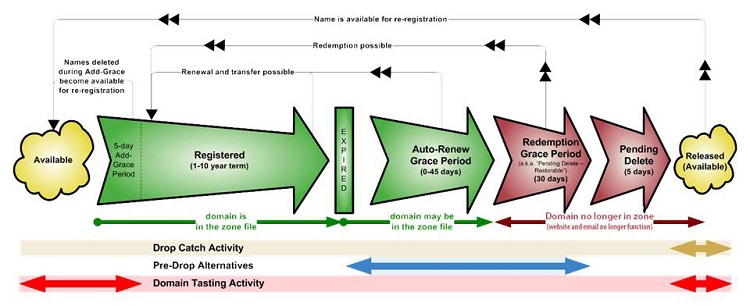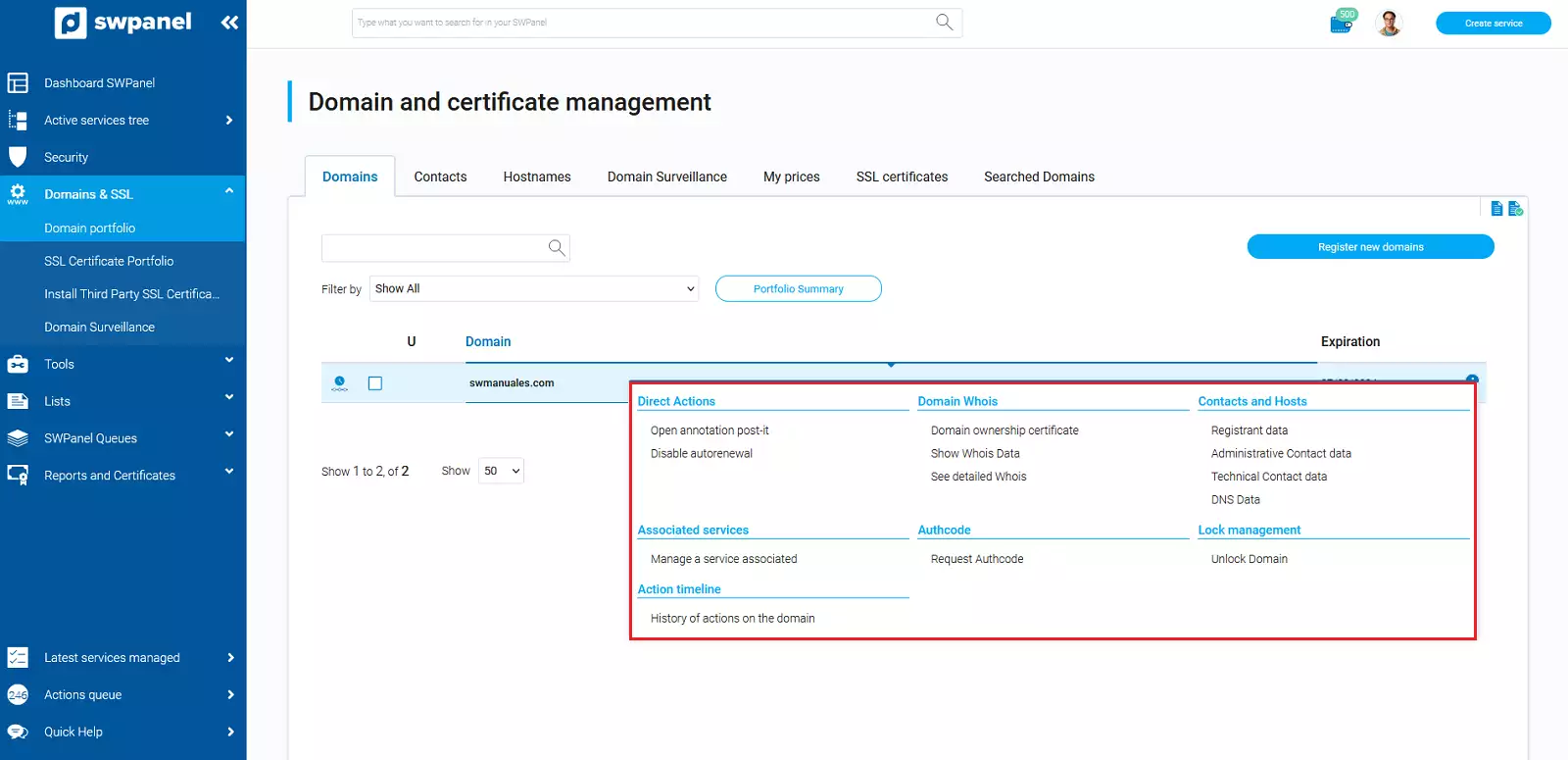Starting with the basic concept of domain, we could say that a domain is the name that identifies a site on the Web and indicates that it belongs to a certain category . In short, a domain is basically the exclusive name used to position a web site, such as "www.swhosting.com".
So far it might seem simple, but behind this nomenclature we can detail a little more about the real meaning of a domain. We all know that a domain is the name of a website that we type in our browser to view the content of it, but actually on the servers the websites are NOT saved directly with the domain name, but web browsers actually access each website using the IP address (Internet Protocol), such as 105. 25.46.22, which identifies the server where the website is located, that is, the domain name is actually a way to facilitate the search and display of web content designed for the user in a more simplified and human way.
In conclusion, we can emphasize that thanks to the domain of a website, it is much easier to remember than a sequence of numbers, as is the case of IP addresses. At the same time, nowadays the same server is used to host different websites, in the case of not having domains, there could only be one website for each IP address / server. In addition to the above, thanks to the domain nomenclature, the movement of web content between servers is much more flexible, because the IP can change, but the domain will remain the same.
A domain name is the first step to make your project a reality. Enjoy the best domain rates.
When viewing the web content of a domain, we have to focus on the system that our machine uses to "translate" or transcribe the domain name you are viewing into an IP, which is the language that the servers understand so that your web browser can communicate with the corresponding server effectively. This "translation" system is called DNS or Domain Name System.
Not all Internet domains follow the same formula. In general, when we talk about domains we refer to the two main types that exist in the top-level domains or TLDs. This is a domain that is at the top level of the Internet domain system. The most common include .com, .org, .net and .edu.
- ccTLDs: Country Code Top Level Domains. Also called geolocated or territorial, they use only two letters as the domain extension and are based on international country codes, such as .es for Spain, .jp for Japan, .mx for Mexico and .co for Colombia. They are often used for companies that are creating dedicated sites for specific regions.
- gTLD: Generic Top Level Domain. They are basically a TLD that do not depend on a country code. In the past, they were intended for a specific use case such as .edu, which is aimed at educational institutions. Today, most of them can be used without restrictions. These domains use at least three letters in their extension as can be seen in the following examples: .mil (military), .gov (government), .org (non-profit organizations) and .net among others.
However, there are also other types of domains:
- Second level domains.
These are domains that lie directly below a top-level domain. For example, British companies occasionally use .co .uk instead of .com. Other examples would be .gov .uk, which are used for government institutions and .ac .uk, for academic institutions and universities.
- Subdomains.
These are useful because they do not require webmasters to purchase an additional web domain to create divisions within their site. Instead, they can create a subdomain that points to a specific directory on the server. They are often used to manage various areas of the same domain such as www. to point to the domain's web page or webmail. to manage the domain's mail via the web.

IIndeed, domains have a life cycle and, depending on whether they have been registered, have expired, etc., they go through different states. The following is a breakdown of the most common ones, to avoid confusion:
- Available or Free The domain is not currently registered by any individual or corporation, so you can register it so that it becomes your property.
- Registered or Occupied The domain is already registered. In this status you will only be able to transfer it if you own it. Otherwise you will not be able to take any action.
- Active Once the domain is registered you can use it and link it, if you wish, to a hosting plan.
- Expired The domain has not been renewed on time and has expired. At this point, first of all, the domain stops working and also goes through different states:
- Grace Period ( Renew Grace Period ). If it has not been renewed while it was active, in this period of time (approximately between 0 and 45 days) the domain stops working, but you can proceed to its recovery for the renewal price of the domain + 20€ + VAT.
- Redemption Grace Period If it has not been renewed while it was active or in grace period, you can still recover the domain, although the price will be much higher as there is a penalty. In this state is usually about 30 days.
- Pending Delete Period. In this state, the domain can no longer be renewed and you simply have to wait (about 5 days) for it to become available again.
It is important to know that all domain extensions are NOT subject to the same duration days in the different states.
There are 2 organizations that are mainly responsible for the management of all Internet domains, IP addresses, DNS servers, etc.
- ICANN (www.icann.org)
- IANA (www.iana.org)
These two international organizations are the ones that accredit other companies or organizations to be accredited registrars to register domains. ICANN, the Internet Corporation for Assigned Names and Numbers, is a non-profit organization created on September 18, 1998 with the objective of taking over certain tasks performed prior to that date by another organization, IANA.
In the case of ccTLD domains for countries, IANA/ICANN delegate their management to non-profit organizations in each country or territory, and it is these organizations that decide who can be "registrars" of these domains.
In Spain, for example, dominio.es, which is part of the Public Business Entity Red.es and which depends on the Spanish Ministry of Industry, Energy and Tourism, is in charge of managing its domains and accrediting the registration agents.
- I want to know if a domain is available.
Just enter it in our domain search engine and it will tell you immediately if the domain you want is available or not.
- I want to know the owner of the domain
Following the implementation of the new European Data Protection Regulation (GDPR), which came into force in May 2018, the personal data of a domain's contacts are no longer publicly displayed. Responsible domain owners can perform the deactivation of Whois hiding and then all contact data associated with the domain would be revealed again: the information that was hidden would be made public.
You can use the whois to find out when a domain will expire. When you access the Whois and enter the domain, you can check it in the "Important Dates" box named Register Expiration Date.
When the domain is already in SW Hosting, you have at your disposal different tools in reference to the domain, such as hiding the whois, blocking... In order to manage the domain, you must do it directly from your domain portfolio.
Here, you will find all the domains you have registered with SW Hosting. Let's break down each of the options that the SWPanel shows you for each of the domains:

- Open Post-It notes You will be able to write down any comments about the selected domain. These notes work internally, so they are not displayed at the Internet level.
- Disable/Enable Auto-renewal This option allows you to activate or deactivate the renewal of your domain so that you do not have to worry about renewing it.
- Renew Domain From this option, you will be able to manually renew your domain.
- Show Whois Data With this button, you can request that the Whois data be made public, i.e. that data such as administrative contact or owner be shown publicly. By default, the Whois is hidden.
- View Detailed Whois This option will show you the data that is currently in the Whois of your domain.
- Owner Data You will be able to visualize the owner's data that currently appears in the domain. If you want to make any modification, you will have to assign a new one, through the contact management.
- Administrative Contact Data You will be able to visualize the administrative contact data currently in the domain. If you want to make any modification, you will only have to assign a new one, through the contact management.
- Technical Contact Data You will be able to visualize the technical contact data currently in the domain. If you want to make any change, you only have to assign a new one, through the contact management.
See this manual for details on domain contact changes.
- DNS data In this section, you will have the option to assign the DNS that you want to be included in the domain.
- Create a service to this Domain. With this option, you will be able to create a Hosting service directly associated to a domain.
- Manage assigned service Here you can manage any hosting service assigned to your domain.
- Request Authcode Here you can request the authcode needed to transfer your domain. Please note that the Authcode is valid for 15 days, after this time, you will have to request it again. Domains with .es extension do not require Authcode to be transferred.
- Block Domain
This option is a security measure to prevent your domain from being transferred.
For more information, please refer to the following manual
How to register a domain from SWPanel
How to register a domain from the web
How to transfer a domain from the web
A domain name is the first step to make your project a reality. Enjoy the best domain rates.